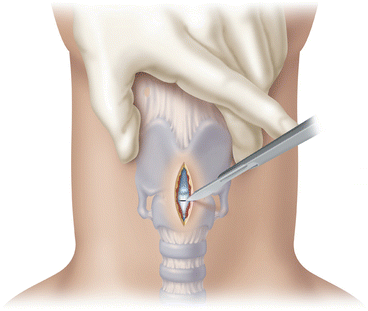and Richard A. Jaffe2
(1)
David Geffen School of Medicine at UCLA, Los Angeles, California, USA
(2)
Stanford University School of Medicine, Stanford, California, USA
Keywords
CricothyrotomyAirway obstructionAirway bleedingUnfortunately on rare occasions, anesthesia providers will experience patients whose lungs cannot be ventilated using a bag-mask technique, an LMA or a tracheal tube. When this occurs, the only alternative may be to do an emergency cricothyrotomy. In this circumstance the central issue is: “Should one use a knife or a needle to establish an emergency airway?” The only reason that there is any debate about this matter is that most anesthesia personnel have no real life experience with either technique, and hence have no way to judge which is better. However, in a life-threatening airway obstruction , there is no question which is better. An emergency cricothyrotomy using a knife is much quicker, easier, safer and more effective than any needle-based technique. There should be no place in emergency airway management for needle-based attempts to establish ventilation. It should be deleted from the ASA Difficult Airway Algorithm , but it probably won’t be because many of the members who design or evaluate the algorithm have never performed either technique in an emergency. The authors have participated in nine cricothyrotomies in emergency airway situations, and all the patients left the hospital without any neurological injury or complications from the cricothyrotomy. Although there are no randomized controlled trials, we believe that the risk-benefit ratio markedly favors the knife technique .
First, a knife cricothyrotomy is quicker and easier since one can find the cricothyroid membrane or tracheal rings and trachea much faster with a knife or scissors than with a needle. We have been teaching routine transtracheal injections to residents for over 50 years, and even after multiple attempts experienced residents still struggle to find the cricothyroid membrane. In an emergency, that delay is unacceptable. With a knife or scissors one cuts quickly either vertically or horizontally through the skin of the neck and then through the cricothyroid membrane, which lies between the thyroid cartilage above and the cricoid cartilage below. The knife is inserted into the trachea and turned 90°, and an airway is established (Fig. 6.1). At that point a small tube of any type can be inserted next to the knife. The knife technique is much safer because there is virtually nothing that one can harm by making an incision near the midline of the neck, and it can be performed in less than 30 s. In contrast, the needle technique is fraught with major problems. These include: identifying the trachea; making certain that the needle is entirely in the trachea, and does not move to avoid causing massive subcutaneous emphysema when an oxygen source is established; establishing a pressurized oxygen delivery system, which will take more than 5 min even in the most experienced environment; and avoiding causing a tension pneumothorax with ventilation against a closed glottis. Finally, the knife technique is more effective. We know of multiple cases of acute airway obstruction where the needle technique was attempted, and in all cases the patient died. We know of no such cases where a knife cricothyrotomy was used as the primary treatment of unresolved acute airway obstruction.








